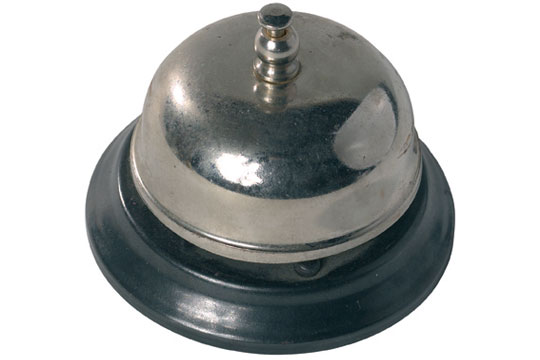
As catechists, we always need to evaluate the way we present lessons to our classes. An approach that may work for one group may not work for another.
For example, I was teaching a frisky group of second graders about the Real Presence of Jesus Christ in the Eucharist. However, all of the old tricks that had been effective with my other classes seemed to fall flat with this group. I was being challenged as a catechist in a way I hadn’t experienced in the past. This group of children needed to be challenged and stimulated in a way that focused and engaged them. If I could present the lesson within a challenging and fun framework, I could help the kids absorb the material. I decided that they would participate in a game I called “God’s Family Feud.”
For this game, I would divide the class into two teams, and each team would need a bell. I went to the local store to find a simple, old-fashioned bell, the kind you would ring on a counter if you needed assistance.
As I scanned the shelves, I began to have some doubts. How could I think of making a game out of the Real Presence? A pang of guilt jabbed me.
As catechists, we constantly have to adapt our teaching styles to meet the needs of the children we serve so they can learn the truths of our Catholic faith. We have to rely on our training, our fellow catechists, and above all, the inspiration of the Holy Spirit to lead us in evangelizing. That pang of guilt gradually subsided—I wasn’t making a game out of the Real Presence of Jesus Christ in the Eucharist; I was simply presenting to children the truth of our faith in a manner they could understand, appreciate, and absorb. I asked an employee for help, and found two bells that were exactly what I had been looking for. I drove away from the store, excited about the upcoming game of “God’s Family Feud.”
I split the class into two groups: Angels (girls) versus Saints (boys). The team names were a cute concept that I borrowed from another catechist. Those names offered a great opportunity for me to explain who the saints were and why they are important to the Church (as well as the fact that girls are saints too), and that angels were spiritual beings who serve God’s plan as messengers. Using questions from the test at the end of the chapter of our books, I had one child from each team step up to a bell. My aide was the referee; she determined who hit their bell first after I read the question. If the child answered correctly, his or her team scored a point. If not, the other team could work together and attempt to answer the question correctly, “stealing” the point.
The children loved competing against each other, and they loved smashing the bell and giving the answer. This class, which was usually hard to manage, became focused and engaged in their learning. They worked beautifully in their groups and learned the value of teamwork. It also taught them the value of paying attention: they had to listen to the other team’s answers and look for an opportunity to steal the question to win the round. The class talked about this activity for weeks after our game. Most importantly, the truth of the Real Presence was becoming as clear as a bell for them.
As catechists, we must be attentive to the children entrusted to our care. We must observe when they are learning and absorbing the material we present and, more importantly, when they’re not. We must not be afraid to try new techniques in engaging our classes, trusting that the Holy Spirit will guide us.
When have you tried a new approach in reaching the children in your faith formation classes? What was their response?




What a beautiful, creative and Spirit-inspired way to get these little ones focused and actually learn something, especially that which is central and so important to our Catholic faith! Too many times, religious ed classes turn into fun and games – ways to keep kids occupied but forgetting the real mission! The children in your class are blessed to have such a faith-filled, loving and caring teacher! God bless you in abundance!
Thank you, Debi. I appreciate your prayers as we start the new school year. God bless you and your work!
Kudos to your creativity, willingness, and determination to *keep* being creative for the gospel, Lisa! Our Communion kiddos are so blessed by you. I am a very proud DRE. 🙂
Thank you for your Christ-like leadership and your prayers.
Lisa,
It is a great blessing to have a catechist that “doesn’t give up” and will go above and beyond to get Christ’s message to those they teach. May God continue to bless your ministry and your family!
Thank you for your blessing!
Here are different approaches I’ve used to implement games with middle and high schoolers:
-I wait until the textbook unit has been completed, then I use the assessment quizzes.
-Or, I use it before a holiday or the end of the year, to get in a festive spirit instead of a party.
-Older kids (6th, 7th, 8th graders; 9th graders are mixed) seem highly motivated to be insightful and responsive when even a small bag of gummy bears or a large chocolate bar is offered as a prize. A large bag of Swedish Fish as a prize is another great incentive.
-In a classroom setting of tables seating some 4 students each, I separate the tables, each of which holds a team. I make sure each table is pre-manned wtih mixed students, quiet and responsive ones. Then, I either:
—use the desk bells pictured in this article, putting two on an unmanned table in the center of the students’ tables. Now the students have to get up and reach the table to be first to ring, adding to the excitement. —use “Buzzers with sounds” from Learning Resources (fairly inexpensive on Amazon). Each buzzer is differently colored, lights up, and makes an individual crazy sound. I put each buzzer on each student table.
–I have an aide or volunteer parent come in and be the final judge as to rang first.
–Sometimes, I use a whiteboard (a batch are also inexpensively found at the dollar store or Amazon) to use as tally boards on each table.
–I bought an Eggspert set (expensive on Amazon). I dragged in a lectern from the hallway being used to hold up a statue, and then placed the Eggspert on it. The students come up in pairs, one each from two pre-determined sides of the room. The Eggspert only records one of the two attempted button presses.
–My ADRE has used her own hands. She has pairs of students from each team come up, and if they know the answer, either grabs her hand and she makes a call about who did first.